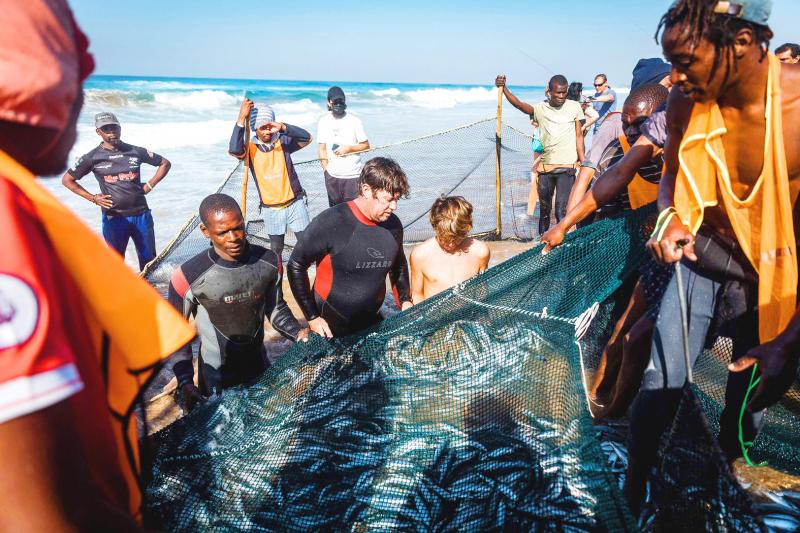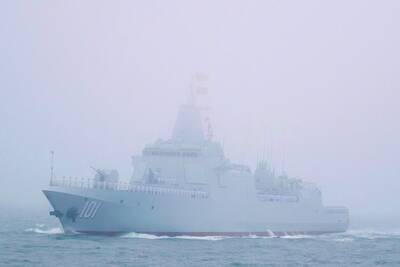Dolphins gracefully popped out of the water, peppering the Indian Ocean’s surface, as sharks rose from the depths and birds dove from the sky — all on the hunt for sardines.
In the crisp air of winter, South Africa’s east coast becomes home to a spectacular annual migration of millions of sardines.
The “sardine run” — which lasts several months and usually peaks in July — attracts a host of marine predators, resulting in a feeding frenzy.

Photo: AFP
“This is a super-pod of common dolphins,” marine biologist Michelle Carpenter said, while perching on the side of a boat as three dolphins dove perfectly synchronized just off the bow.
As the ripples of foamy waters rolled through, a flurry of Cape gannets tucked in their wings in succession, diving from the clear blue skies like arrows into the dark waves.
A shape-shifting silvery ball of sardines grouped together glided through the water in unison below the waves: a “bait ball.”

Photo: AFP
Separated from the main shoal, which can be several kilometers long, they were surrounded and then herded up to the surface by the dolphins.
The feasting could begin.
This choreographed dance of nature is possible because of the symbiotic relationship between the different predators.
“Sardines are always looking for depth, for protection ... so they try to go down deep. That’s where the sharks come in,” professional diver Gary Snodgrass said. “So you have the sharks at the bottom and the dolphins around the edges, basically stopping the sardines from running away.”
Then, the most menacing guest arrived, a dusky shark with its fear-inducing dorsal fin, stealthily weaving its way into the banquet feast.
Under the surface, wetsuit-clad spectators kept their distance, watching the feeding frenzy as the sardines frantically tried to escape.
However, within minutes, their shoal was decimated — the dining ended and the guests took their leave.
Their binge was to be repeated over and over during the three to four months of the migration — until the sardines disappear back into the open ocean.
The reason behind the “sardine run” is not exactly known, but scientists believe that it is linked to their reproductive cycle.
Those who saw the feast from under the waves took away indelible memories.
“Amazing,” said French diver Laurent, who did not give his surname. “The shark was the cherry on the cake — incredible. The shark didn’t bite us. It was the best time ever.”
As calm returned to the sea’s surface, a silvery constellation of fish scales trickled like stardust into the deep.

ELECTION DISTRACTION? When attention shifted away from the fight against the militants to politics, losses and setbacks in the battlefield increased, an analyst said Recent clashes in Somalia’s semi-autonomous Jubaland region are alarming experts, exposing cracks in the country’s federal system and creating an opening for militant group al-Shabaab to gain ground. Following years of conflict, Somalia is a loose federation of five semi-autonomous member states — Puntland, Jubaland, Galmudug, Hirshabelle and South West — that maintain often fractious relations with the central government in the capital, Mogadishu. However, ahead of elections next year, Somalia has sought to assert control over its member states, which security analysts said has created gaps for al-Shabaab infiltration. Last week, two Somalian soldiers were killed in clashes between pro-government forces and

Ten cheetah cubs held in captivity since birth and destined for international wildlife trade markets have been rescued in Somaliland, a breakaway region of Somalia. They were all in stable condition despite all of them having been undernourished and limping due to being tied in captivity for months, said Laurie Marker, founder of the Cheetah Conservation Fund, which is caring for the cubs. One eight-month-old cub was unable to walk after been tied up for six months, while a five-month-old was “very malnourished [a bag of bones], with sores all over her body and full of botfly maggots which are under the

BRUSHED OFF: An ambassador to Australia previously said that Beijing does not see a reason to apologize for its naval exercises and military maneuvers in international areas China set off alarm bells in New Zealand when it dispatched powerful warships on unprecedented missions in the South Pacific without explanation, military documents showed. Beijing has spent years expanding its reach in the southern Pacific Ocean, courting island nations with new hospitals, freshly paved roads and generous offers of climate aid. However, these diplomatic efforts have increasingly been accompanied by more overt displays of military power. Three Chinese warships sailed the Tasman Sea between Australia and New Zealand in February, the first time such a task group had been sighted in those waters. “We have never seen vessels with this capability

‘NO INTEGRITY’: The chief judge expressed concern over how the sentence would be perceived given that military detention is believed to be easier than civilian prison A military court yesterday sentenced a New Zealand soldier to two years’ detention for attempting to spy for a foreign power. The soldier, whose name has been suppressed, admitted to attempted espionage, accessing a computer system for a dishonest purpose and knowingly possessing an objectionable publication. He was ordered into military detention at Burnham Military Camp near Christchurch and would be dismissed from the New Zealand Defence Force at the end of his sentence. His admission and its acceptance by the court marked the first spying conviction in New Zealand’s history. The soldier would be paid at half his previous rate until his dismissal